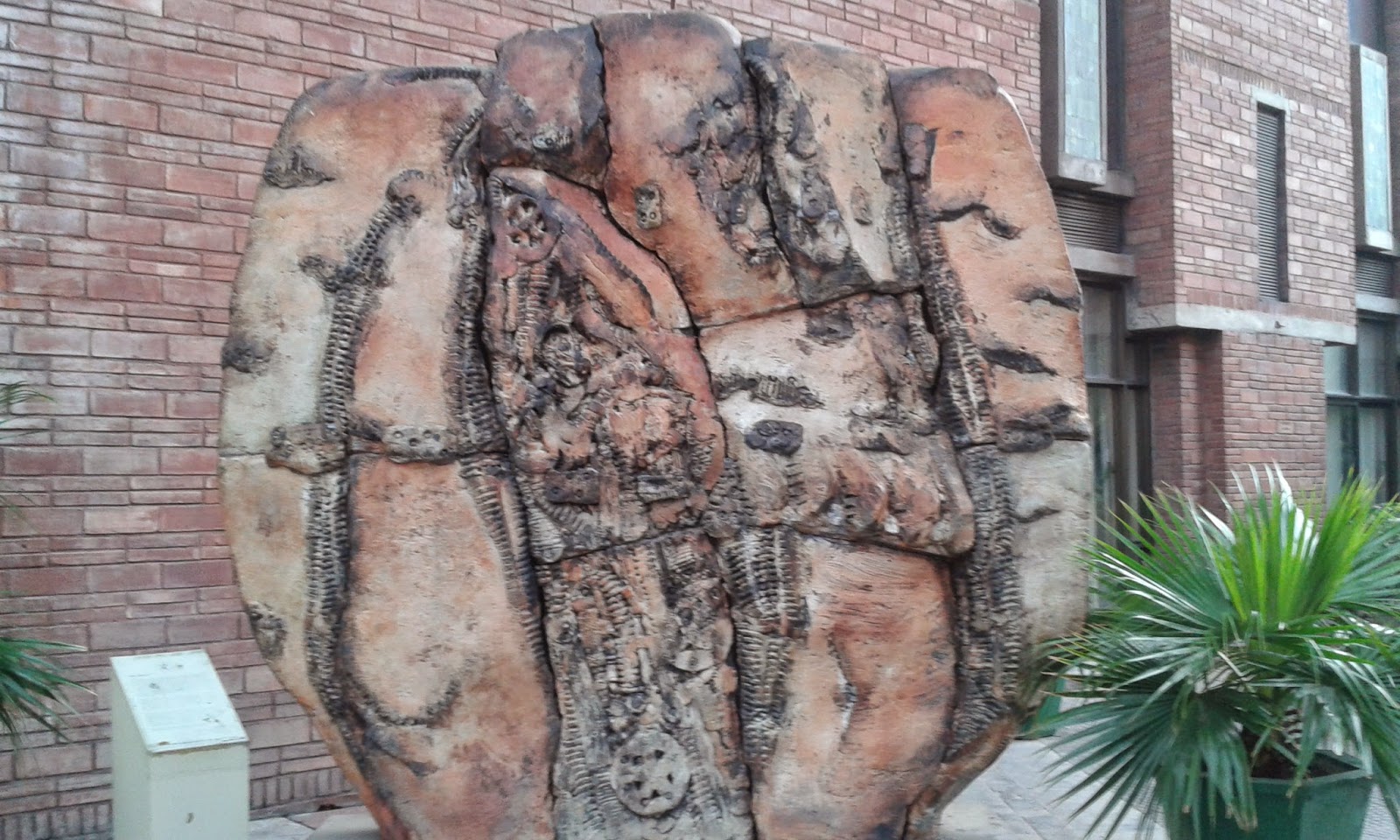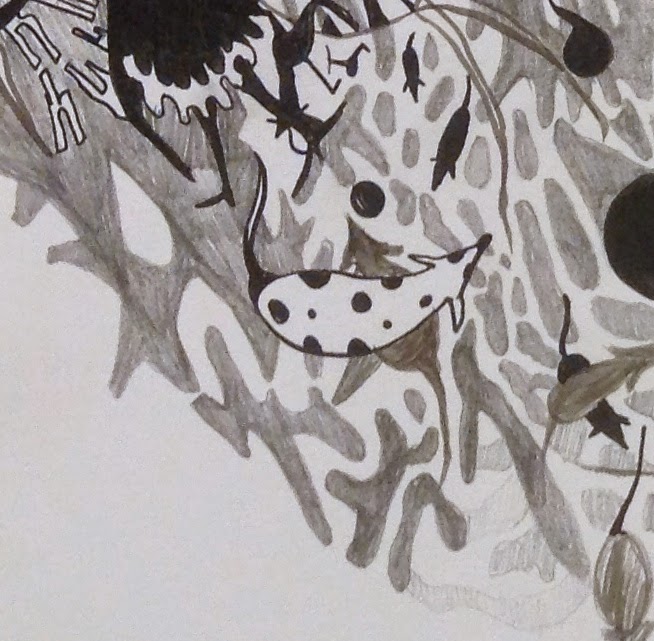It was a cold foggy morning as we assembled at the Qutub Minar Complex for the INTACH
talk. Visitors had already started pouring in although it was 9 am on a Sunday
morning! Huddled in a group, we listened as Dr Swapna Liddle gave a brief
history of the Qutub Minar Complex,
its rulers and architects.
The Qutub Minar
complex had originally been built as a mosque, a place of worship for large
congregations. The Turks had arrived in the city and they were keen to mark
their reign. The typical Turk
architectural features were often the dome and the true arches. However, as Dr
Liddle hypothesized, the language may have been a barrier and the Indians would
have had their own demands, the end result was an interesting blend of
Islamic-Indian styles or in our words, jugaad!
At the entrance and inside the complex contained the old
pillars taken from the Jain temples. Twenty seven Jain temples had been
demolished and these pillars had been reinstalled in the complex. Each pillar
had a kirti muk, a demon face with a ferocious expression and
baring its teeth. Its role was to ward off the evil eye and was seen as an
important figure for places of worship. The second recurring motif was the kalash that was placed below the kirti muk. The kalash,
an auspicious and ceremonial pot of mango leaves and coconut, was a symbol
of abundance and remover of obstacles. The third motif was the bell shape
pattern. It is believed to be a Vishnu image. The diamond shape pattern was the
fourth motif to be observed on the pillars. It was a popular decorative element
regularly used in Indian architecture and possibly used to balance and
harmonize the composition on the pillars. Below the bell shape engravings were
little shrines of gods and goddesses. Most of them had been defaced, as ancient
Islam did not believe in iconography and viewed God as an abstract Being.
As we progressed to the centre of the complex where the Iron
Pillar rests, we were told how certain pillars had been freshly carved as the
old ones were no longer available. Random rubble masonry was used for the newer
pillars. The new materials contained the limestone mortar and organic elements
like urad dal, cow dung to bind the rough
stones together. As with the older pillars, the motifs engraved into the stone
were -:
1)
The kalash
2)
Verses of the Quran
3)
The lotus flower
4)
Symbols of river Goddesses- Yamuna and Ganga
The Quranic inscriptions were interspersed with the lotus
flowers while the Makar/crocodile
motif associated with Ganga contained pronounced circular patterns of the
crocodile’s tail. Yamuna’s vahana or vehicle was the tortoise and imprinted
with less circular waves than that of Ganga. The different motifs were stitched
together to create a beautiful composite
culture.
At Illtutmish’s tomb,
one could see how certain technological and artistic changes had made to the
structure. Pink sandstone and marble made their presence. The materials had
improved and newer forms of calligraphy had arrived. The Naskh script had been introduced as well as the Kufric. The kalash motif still remained though more stylized than its previous
predecessors. The motifs of the river Goddesses , Ganga and Yamuna had fallen
by the side or not clearly imprinted on stone. The shrine motifs had become
ornamental and the true arch had not yet emerged. The typical Turkish dome also
had not yet arrived. These additions were soon seen in our next stop- Khalji’s tomb.
Khalji’s tomb saw
the appearance of the dome and the true arch at last. Though austere and bereft
of any ornamentation, the massive imposing architecture by itself told a
different story. From there, we moved to
the grand Alai Darwaza. It had been
built as a gateway to the complex. One could see how the Sultanate had grown
and prospered during those centuries. In the centre of the dome was the marble
centerpiece while the later layers were in red sandstone. The arches on the
sides of the structure contained the lotus pattern fringes and the six pointed
star (which is also there in Humanyun’s tomb). The star consisted of two
equilateral triangles and symbolized the union of god Shiva and goddess Shakti.
We also discussed and compared
the domes of the Alai Darwaza and Imam Zamin’s tomb. The kalash was present on both the domes. On
Imam Zamin’s tomb, it had been taken
a step further. A tiny stupika had
been placed on top of the kalash. Again, it was unusual as such
stupas were often seen in the Buddhist architecture. Not much information is
known about the man except for the sole inscription on the tomb. The outer
walls of the tomb contained a three- dimensional lotus flower often seen in
Buddhist as well as in Hindu iconography.
Kept for the last and the best was the Qutub Minar itself. It had the best of all the motifs and patterns put together on this towering structure. It contained the
1) The diamond shape motifs
2) Floral motifs
3) Calligraphy motifs
4) Bells
5) Star shaped motifs
 |
| The Makar Motif |
 |
| River Goddess Ganga's circular waves |
 |
| Illtutmish's tomb |
 |
| The kirti muk, kalash and bell |
 |
| Small shrines on the pillar |
 |
| Near the Iron Pillar. Note the stylised kalash |
 |
| The older kalash at the entrance |
The two hour walk came to an end and some remained behind to
ask Dr Liddle more questions about the Qutub
Minar Complex. In the meantime, Dr Liddle added that she would be
conducting two walks- 4th February and 11th February
during the National Heritage Month. One would be at the St James Church while
the other one would be done at Daryaganj. To know more updates, check the
INTACH Facebook page https://www.facebook.com/Intach-Heritage-Walks-199442496810218/
or check their website www.intachdelhichapter.org
#INTACH #SYMBOLS #MOTIFS #QUTUBMINARCOMPLEX #JANUARYEVENTS #SWAPNALIDDLE































